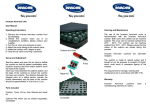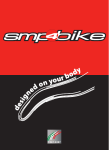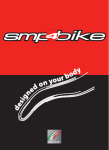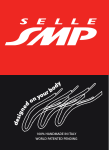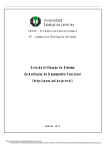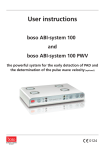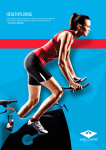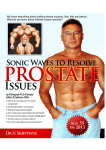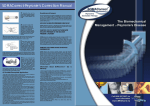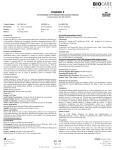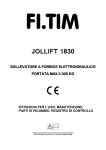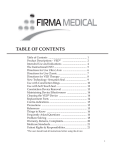Download SMP Saddle Assembly Instructions
Transcript
PRO 0% 20% GB The buyer owns the rights guaranteed by the Legislative Decree 6 September 2005, n. 206 “Consumer Code”. Selle SMP directly guarantees this product for 24 months from the purchase date appearing on the receipt issued by the retailer if a full product description is included. Repairs under warranty: Any interventions under warranty refer exclusively to the free replacement or repair of any parts that have a manufacturing fault. Selle SMP reserves complete discretion over the replacement of all or part of the saddle with another with the same or similar features; however there will be no guarantee extension in the event any replacements or repairs are made. The guarantee does not cover: • The parts subject to wear and tear • Damage caused by neglect, incorrect use or installation • Damage caused by use which is improper or not in accordance with the warnings described in the instructions for use, installation and maintenance • The small external faults that do not affect the functionality of the product • Damage caused by factors unrelated to the product The guarantee is void if the instructions given herein are not complied with. No amendments of any nature may be made to this guarantee. The original language of this manual is Italian and the Italian version shall be referred to in the event of any doubts as to its interpretation. Every dispute, without exception, will be referred exclusively to the Court of Padua. Notes: Note 1: eventual replacements of parts subject to wear are carried out at the sole discretion of Selle SMP, and in any case will not be made later than three years from the date of purchase. The costs of this type of intervention are the responsibility of the user. Note 2: Superficial alterations or colour loss, even with limited use, and especially on light-coloured linings (white, yellow etc.) are considered a natural process resulting from use and exposure to weather conditions and are not covered by the warranty. Note 3: All Selle SMP products are tested and guaranteed under the terms of UNI EN 14764, UNI EN 14765, UNI EN 14766, UNI EN 14781. Note 4: Variations in weight of 15% more or less than the nominal value are due to the craftsmanship of the components and are considered absolutely normal. 2 Thank you for choosing Selle SMP. We have been manufacturing saddles with the same care and passion since 1947. The saddle in your hands was conceived, designed and produced entirely and exclusively in Italy. Obviously, we are extremely proud! We are confident that you will be fully satisfied but we would still appreciate any comment you may have. Simply visit: www.sellesmp.com Franco and Maurizio Schiavon FR GB DE GB ES NL CHI KR JAP 3 PRO 20% 3 80% CENTRAL CHANNEL 100% the result of extensive biomechanic studies on saddle positioning and on the structure of the human pelvis, it is distributed over the whole length of the saddle, from the rear to the tip. Whatever the position assumed by the cyclist, it avoids compression of the perineal structures, preventing on the one hand the risk of vein, artery and capillary occlusion (erectile dysfunction, anorgasmia and urination difficulties), and on the other hand, the occurrence of nerve injury (among the most common being tingling and numbness). 1 REAR DEPRESSION protects the coccyx from bruises and shocks caused by the roughness of the terrain. 5 4 SITTING POSITION is shared between the buttocks, the ischial tuberosities and the high branch of the ischium. Depending on its anatomical configuration you can choose from 15 different configurations of shape and padding. 2 4 “EAGLE BEAK” TIP designed to allow the rider to adopt even extremely low positions on the handlebars that involve an increased prone rotation of the pelvis, comfortably and without crushing of the uro-genital area. The exclusive shape of the nose also constitutes an ideal support base for the classic “thrust” style of pedalling. FRAME LENGTH the saddle is by far the part that most influences the cycling position. The SMP saddle seat tube offers the widest adjustment range and allows any person to find the perfect forward/backward saddle positioning, like on a made to measure bike. 5 MEDICAL RESEARCH Cycling stresses the human body more than you think and can generate consequences that should be looked into. SMP’s medical research has reviewed sixty two international scientific publications which revealed that cyclists suffer many common problems and pathologies in various parts of their bodies: CHRONIC PAIN found in between 50% and 91% of the cyclists considered; it is associated with genital-perinea desensitisation and consequent moderate to severe erectile dysfunction in 13% to 24% of cases. INJURIES constant and prolonged contact between the saddle and perineal region can cause various types of injuries including calluses, ulcers, skin irritations or boils with folliculitis. The most typical perineal nodular lesion is the so-called ‘biker’s nodule’ or the ‘third testicle’. Usually this nodule looks like an elastic-callus a few centimetres long, covered in skin. Surgical removal is normally indicated as primary therapy. 2 1 4 6 1 PERINEAL ZONE TINGLING due to the reduction in blood flow which is a consequence of prolonged local circulatory duct compression. 3 2 BLADDER AND KIDNEYS HAEMATURIA this consists of blood in the urine. Haematuria of exertion or traumatic origin, due to repeated micro-traumas to the bladder and kidneys, is directly proportionate to the duration of physical activity. 3 PENIS PRIAPISM due to a more copious and abnormal blood flow into the corpora cavernosa of the penis and consists of lasting painful erection. It is consequent to vascular trauma with the formation of arterial-venous fistula. 4 TESTICLES PSA SERUM VALUES after cycling, probably caused by compression of the saddle on the perineum region and thus also on the prostate gland. Cyclists with prostate cancer and those with PSA serum levels over the norm, especially over the age 50, should be informed of this possible effect. INFERTILITY prolonged physical activity causes an increase in scrotal temperature which damages sperm generation and changes the hormonal axis of the hypothalamus-hypophysis-testicular axis. TESTICULAR TUMOUR significant increase in the risk of testicular seminoma in cyclists probably connected with repeated and frequent scrotal traumas; however other researchers, concerning this same question, prefer to emphasize how physical activity is a protective factor with regards to neoplasias and that this, to a certain extent, balances GB out the greater incidence of neoplasm in cyclists. TORSION OF THE SPERMATIC CORD association of this event with cycling is still controversial and debatable; the cause of torsion may be linked to an endoscrotal movement of the testicles while pedalling, accompanied by a vigorous contraction of the cremaster muscles. 5 FEMALE BODY In the female body, from an anatomical standpoint, the neurovascular structures compressed by the saddle are the same as those in the male body. Thus women also suffer from problems and dysfunctions linked to cycling. The main and most frequent ones are anorgasmia, ulcerations and lymphoedema of the labia majora, urination difficulties, chronic perineal pain and haematuria. 7 70% of CYCLISTS, BIKE RIDERS and CYCLING HOLIDAYMAKERS, MEN and WOMEN have blood circulation problems! Development of a New Geometric Bicycle Saddle for the Maintenance of Genital Perineal Vascular Perfusion The Journal of Sexual Medicine July 2005 G. Breda, MD - N. Piazza, MD - A.Caruso, MD: Department of Urology, S. Bassiano Hospital, Bassano del Grappa (VI), Italy; V. Bernardi, MD: Department of Urology, SS. Giovanni and Paolo Hospital, Venice, Italy; E. Lunardon, MD: Department of Anaesthesia, S. Bassiano Hospital, Bassano del Grappa (VI), Italy. Measurement of the pressure in the intestinal region through the penile transcutaneous oxygen pressure (PTCO 2 in mm / Hg) on an SMP saddle and on a saddle widely used by professional cyclists. values after 3 min 10 min 25 min SMP 49.4 50.6 52.2 Other saddle 25.3 32.6 28.5 +83% CONCLUSIONS Compression of the perineum area causes crushing of neuro-vascular structures with possible consequences on erectile physiology. Bicycle saddle geometry can be a determinant factor in reducing compression and, thus, is an important parameter to be considered and evaluated when choosing a saddle. The results obtained demonstrate that SMP saddles guarantee higher penis blood flow and are now the best solution on the market for the highest performance with the greatest health benefits. 8 INSTRUCTIONS FOR ASSEMBLY MBLY 1 • GENERAL PRINCIPLES Our saddles are designed to distribute body weight between the buttocks and lower part of the pelvic bone. The weight balance and comfort therefore depend on how the ischial tuberosities rest on the saddle while pedalling. This position depends on various factors: GB • the height of the saddle in relation to the pedals • the distance between the saddle and the handlebars • the tilt of the saddle These parameters are adjusted by the cyclist according to their personal characteristics; for best results it is essential to perform the installation by following the steps in the procedure described in the following pages. 2 • PRELIMINARY POSITION On a new frame Secure the saddle observing the distance from the handlebar and saddle height recommended by the bicycle manufacturer based on your measurements. Replacing the old saddle 1. 2. 3. measure the distance from the old saddle to the handlebars measure the distance between the upper side of the saddle and the central movement rotation centre place the new SMP saddle using as a reference the same measures 9 SADDLE - HANDLE BAR DIST ANCE ENTR LE - C SADD N VEME O AL M HT T HEIG 3 • LEVELLING Using a level, adjust tilt using the clamp so that the saddle is horizontal. 4 • FINE ADJUSTMENT (ROAD TEST) Once the saddle is positioned following the previous instructions, use an Allen key on the clamp to make fine adjustments to how the saddle +10right mm /+1/3 inch “feels” until you find your perfect balance on the saddle and the 0 compromise between the saddle pillar and ischial tuberosities.-10 mm / -1/3 inch -25 mm/ -1 inch The saddle nose tilt can be adjusted between + 10 and - 25 mm 10 +10 mm /+1/3 inch 0 -10 mm / -1/3 inch -25 mm/ -1 inch 0 5 10 15 mm and the distance between the saddle point and handlebars can be reduced by 5 - 10 - 15 mm. GB 5 • RECOMMENDATIONS REGARDING THE PILLAR The pillar has a significant impact on saddle frame resistance: For this reason Selle SMP recommends a pillar with the following characteristics: 1. it should allow correct saddle positioning 2. it should not have sharp edges which, by cutting, could compromise saddle frame resistance 11 3. the jaws should have the same external surface shape as the saddle frame to correctly fit with a wide contact surface. 32 mm 8 mm 8 mm 8 mm 8 mm 32 mm 0 1 12 2 3 4 5 0 1 2 3 4 5 6 7 8 0 1 2 3 4 5 6 7 8 0 1 2 3 4 5 6 7 8 0 1 2 3 4 5 6 7 8 6 7 8 6 7 8 0 1 2 3 4 5 4. the contact area between the pillar and the saddle frame should not be under 8 cm2 5. the jaws should connect with the saddle frame for a minimum length of 32 mm 0 1 2 3 32 mm 8 mm 8 mm 8 mm 8 mm GB 32 mm 6. the coupling surfaces with the saddle frame should be symmetrical and parallel 7. the jaws should not cause deformation or damage to the saddle frame 8. the pillar jaws should not protrude beyond the graphed area 0 0 1 0 2 1 3 2 4 3 5 4 6 57 6 8 7 8 0 1 0 2 1 3 2 4 3 5 4 6 57 6 8 7 8 0 10 10 21 21 32 32 43 43 4 5 4 5 65 65 76 76 87 8 87 8 13 9. the closing torque recommended by the pillar manufacturer must be strictly abided by 10. the pillar must meet UNI EN 14781 European standards - Racing bicycle - Test requirements and methods and UNI EN 14766 Mountain bike - Safety requirements and test methods ADDITIONAL PILLAR REQUIREMENTS For saddles with carbon fibre chassis (Full Carbon and CRB versions) 11. If a lateral clamp pillar is used, we recommend using jaws with a range and profile suited to house the carbon fibre saddle frame with 7.1 x 9.6 mm. 0 1 2 3 4 5 6 7 8 For further information, please refer to the pillar manufacturer’s instructions. 14 MAINTENANCE AND CHECKS Any small imperfections in your SMP saddle are the best guarantee that it is a product finished by hand with great care. Surface alterations or colour loss, even with limited use, should be considered natural due to use and exposure to the elements. Particular types of sweat and anti-irritant creams could ruin the lining. GB LINING MAINTENANCE • Clean using a damp chamois cloth or products recommended by Selle SMP. • Do not use detergents or pressurised water jets. • To improve resistance to rubbing, prolong the life and protect the lining of your saddle while promoting cleanliness, we recommend the periodic use of SMP Saddle Leather Wipes. Failure to follow these instructions could damage saddle lining. SAFETY CHECKS • Periodically check that the pillar lock has not “loosened”, tighten it when necessary; • Periodically check that there is no movement/play between the “fork” (metal frame) and the “body” (plastic frame). If there is movement do not use the saddle and consult your local Selle SMP dealer; • If the saddle makes noise, try to eliminate it by carefully cleaning and lubricating the couplings with the pillar; • Check that there are no obvious signs of damage on the saddle. If so, do not use it; 15 • Check that the carbon parts are not broken. If so, do not use (slight signs of wear or bubbles on the external transparent paint do not compromise product safety or functions). LIMITATIONS OF USE SMP saddles are the most technically and clinically advanced saddles available on the market. However, tampering with or improperly using any type of saddle is not advisable since this could cause damage, even after short use. Given the type of product, its working life is mainly determined by the conditions of use. Kilometres covered, roads, atmospheric and climate conditions, the user’s physical and bio-dynamic characteristics are the main factors that determine longer or shorter service life. Regardless of its state of wear and tear, we recommend you replace the product after 15,000/20,000 km of use. Regardless of the intensity of use, the saddle must be replaced whenever certain or suspected damage is discovered. 16 WARNINGS ATTENTION Always use great care and attention when installing this Selle SMP product on your bicycle and follow the attached instructions carefully; • incorrect installation can be dangerous for your health; • use this Selle SMP product if you are in good physical and mental health; • never use this Selle SMP product negligently; • you are responsible for your safety and the safety of others when you use this Selle SMP product. GENERAL WARNINGS The user of this Selle SMP Product recognises and accepts all risks associated with conducting a means of transport which include, among other things, the risk of breakage of the saddle which could cause accidents and may result in serious injury or death. By using this product, the user freely consents to admit and accept all risks, known and unknown, of bodily injury, and death to themselves and to third parties caused by the use of the saddle, including those resulting from active or passive negligence by Selle SMP or of hidden product defects, latent or evident. The risks inherent in the use of this product can be greatly reduced by following the reference guide - user manual - attached to the product. The user also agrees to relieve Selle SMP and its distributors and resellers from any responsibility for any eventual damage, to the extent permitted by law. GB SAFETY As lovers of cycling we are convinced that this is one of the world’s most beautiful sports, however we should always be aware that we expose ourselves to some dangers, maybe even mortal in nature. Dangers linked to the Selle SMP product: • injury to the perineal structures; • injury caused by impact and compression with elements/parts of the saddle; • damage to the plastic frame and/or the metal frame, with the formation of sharp edges and points, following collisions and/or falls; • decoupling of the saddle from the frame attachment system (e.g. pillar); • carbon saddles like all other carbon components used in bicycles, entail greater risks if used for mountain biking. This list of dangers cannot be complete. The basic rules for the use of this product correspond to those of common sense. The hazards can be reduced if the product is installed, used and maintained following the instructions contained in this manual. 17 Selle SMP sas - Via Einstein, 5 - 35020 Casalserugo (PD) - Italy Tel. +39 049 643966 - Fax +39 049 8740106 - [email protected] ISO 9001:2008 certified 18 sellesmp.com We are not liable for any errors in this brochure and reserve the right to change products as we deem necessary, without jeopardising features. Mod LI1 rev.Nov14 Devised in Italy, Made only in Italy, sold all over the world



















